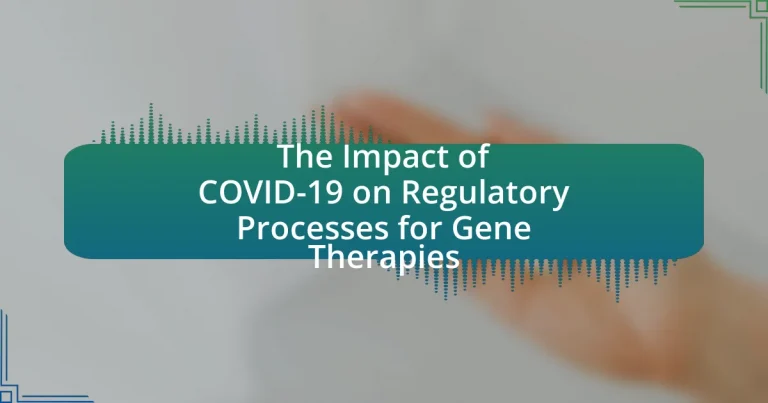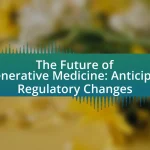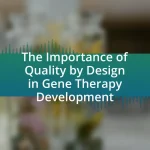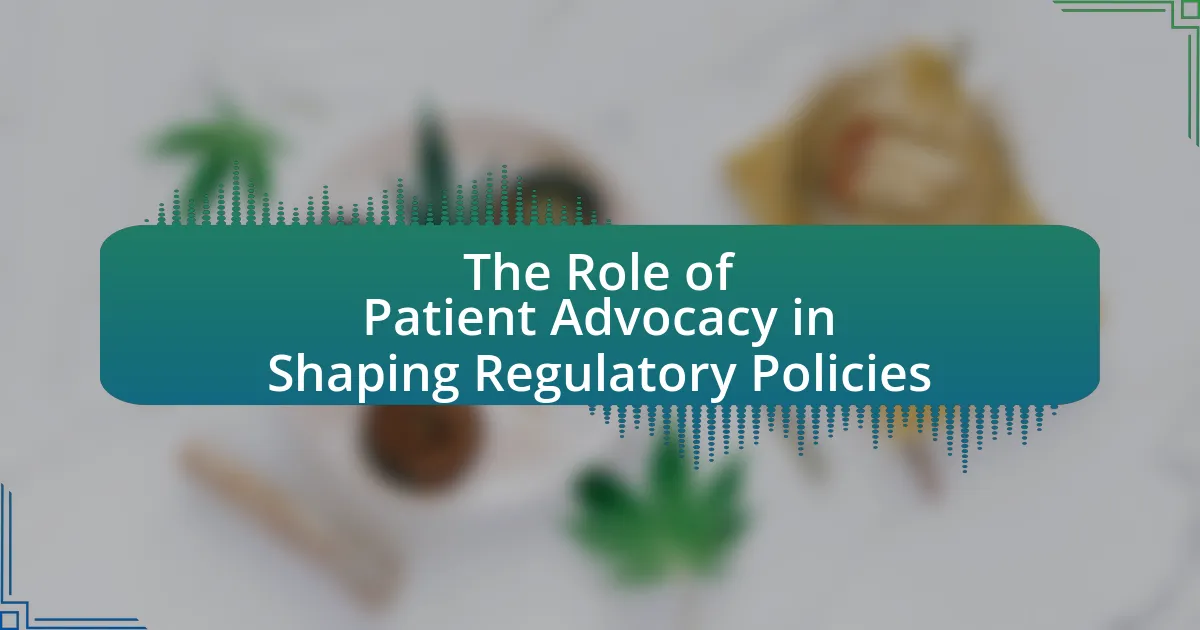The article examines the significant impact of COVID-19 on regulatory processes for gene therapies, highlighting expedited review timelines and increased flexibility in regulatory requirements implemented by agencies such as the FDA and EMA. It discusses how the pandemic led to both accelerated approval pathways and challenges, including resource reallocations and delays in clinical trials. The article also explores specific regulatory changes, innovations prompted by the pandemic, and the lessons learned for future gene therapy regulations, emphasizing the importance of adaptive frameworks and proactive strategies for compliance in a rapidly evolving landscape.

What is the Impact of COVID-19 on Regulatory Processes for Gene Therapies?
The impact of COVID-19 on regulatory processes for gene therapies has been significant, leading to expedited review timelines and increased flexibility in regulatory requirements. Regulatory agencies, such as the FDA and EMA, implemented measures to facilitate the rapid development and approval of gene therapies in response to the pandemic, including the use of rolling reviews and virtual consultations. For instance, the FDA’s guidance during the pandemic emphasized the importance of maintaining patient safety while allowing for accelerated access to innovative therapies, which resulted in a more streamlined process for gene therapy applications. This shift reflects a broader trend towards adaptive regulatory frameworks that prioritize timely access to critical treatments while ensuring compliance with safety standards.
How has the COVID-19 pandemic affected the approval timelines for gene therapies?
The COVID-19 pandemic has extended the approval timelines for gene therapies due to regulatory delays and resource reallocations. Regulatory agencies, such as the FDA, faced increased workloads and prioritized COVID-19-related applications, which slowed the review processes for other therapies. For instance, the FDA reported that while it continued to approve therapies, the overall pace of new drug approvals decreased by approximately 20% during the peak of the pandemic, affecting gene therapies specifically.
What specific regulatory changes were implemented during the pandemic?
During the pandemic, specific regulatory changes included the expedited review processes for gene therapies by agencies such as the FDA and EMA. These changes allowed for faster approval timelines and the implementation of rolling reviews, enabling companies to submit data as it became available rather than waiting for complete datasets. For instance, the FDA introduced the Coronavirus Treatment Acceleration Program (CTAP) to facilitate the development of therapies, which included gene therapies targeting COVID-19. Additionally, the EMA adopted a similar approach with its adaptive pathways initiative, allowing for earlier patient access to innovative treatments. These regulatory adaptations were aimed at addressing urgent public health needs while maintaining safety and efficacy standards.
How have these changes influenced the speed of gene therapy development?
The changes in regulatory processes due to COVID-19 have significantly accelerated the speed of gene therapy development. Regulatory agencies, such as the FDA, implemented expedited review pathways and increased flexibility in clinical trial designs to address urgent public health needs. For instance, the FDA’s Emergency Use Authorization (EUA) allowed for faster approval of gene therapies that demonstrated promising results in early trials, reducing the typical timeline for bringing therapies to market. This shift has led to a notable increase in the number of gene therapies entering clinical trials, with over 1,000 gene therapy trials initiated in 2021 alone, reflecting a rapid response to the pandemic’s challenges.
What challenges have arisen in regulatory processes for gene therapies due to COVID-19?
The COVID-19 pandemic has introduced significant challenges in the regulatory processes for gene therapies, primarily due to resource allocation and operational disruptions. Regulatory agencies, such as the FDA and EMA, faced increased workloads related to COVID-19 vaccine approvals, which diverted attention and resources away from gene therapy applications. Additionally, the pandemic caused delays in clinical trials and manufacturing processes, as many facilities were repurposed for COVID-19-related activities, leading to slower progress in gene therapy development. These disruptions have resulted in extended timelines for approvals and increased uncertainty for developers in the gene therapy sector.
How has the pandemic impacted clinical trial operations for gene therapies?
The pandemic has significantly disrupted clinical trial operations for gene therapies by causing delays in patient recruitment and site initiation. Many clinical trials faced suspension or modification due to lockdowns and restrictions on in-person visits, leading to a backlog in enrollment and data collection. According to a survey conducted by the Biotechnology Innovation Organization, 80% of clinical trial sponsors reported delays in their studies, with gene therapy trials particularly affected due to their reliance on specialized facilities and patient populations. Additionally, regulatory agencies adapted their processes, allowing for remote monitoring and virtual visits, which altered traditional trial methodologies.
What logistical issues have regulators faced during the pandemic?
Regulators have faced significant logistical issues during the pandemic, primarily due to disruptions in supply chains and the need for remote operations. These challenges have hindered the timely review and approval of gene therapies, as essential materials and data required for evaluations were delayed or unavailable. For instance, the pandemic caused widespread travel restrictions, limiting on-site inspections and interactions with manufacturers, which are crucial for ensuring compliance with regulatory standards. Additionally, the increased demand for healthcare resources diverted attention and personnel away from regulatory functions, further complicating the oversight of gene therapy developments.
What opportunities have emerged for gene therapy regulation during the COVID-19 pandemic?
The COVID-19 pandemic has created opportunities for gene therapy regulation by accelerating the adoption of adaptive regulatory frameworks. Regulatory agencies, such as the FDA and EMA, have implemented expedited pathways for gene therapies, allowing for faster approvals and flexibility in clinical trial designs. For instance, the FDA’s Emergency Use Authorization (EUA) has enabled quicker access to innovative therapies, which has been crucial in addressing urgent health needs during the pandemic. Additionally, the pandemic has fostered increased collaboration between regulatory bodies and industry stakeholders, enhancing the sharing of data and best practices. This collaborative environment has the potential to streamline the regulatory process for gene therapies, ultimately benefiting patients with rare and complex diseases.
How have regulatory agencies adapted to facilitate gene therapy approvals?
Regulatory agencies have adapted to facilitate gene therapy approvals by implementing expedited review processes and providing clear guidance on clinical trial designs. For instance, the U.S. Food and Drug Administration (FDA) introduced the Regenerative Medicine Advanced Therapy (RMAT) designation, which allows for faster development and review of therapies that treat serious conditions. Additionally, during the COVID-19 pandemic, agencies like the European Medicines Agency (EMA) and the FDA increased flexibility in regulatory submissions, allowing for rolling reviews and remote inspections to maintain progress in gene therapy approvals. These adaptations are evidenced by the accelerated approval of several gene therapies during this period, demonstrating a commitment to innovation while ensuring patient safety.
What innovations in regulatory processes have been prompted by the pandemic?
The pandemic has prompted innovations in regulatory processes, particularly through the expedited approval pathways for gene therapies. Regulatory agencies, such as the FDA and EMA, implemented emergency use authorizations and rolling reviews to accelerate the evaluation of therapies aimed at COVID-19 and other urgent health needs. For instance, the FDA’s Project Orbis allows simultaneous submission of applications across multiple countries, enhancing global collaboration. These changes have demonstrated the effectiveness of adaptive trial designs and real-time data sharing, which can significantly reduce the time from development to market for critical therapies.
How does the impact of COVID-19 on regulatory processes compare to past health crises?
The impact of COVID-19 on regulatory processes is more significant and expedited compared to past health crises, such as the H1N1 pandemic and the Ebola outbreak. During COVID-19, regulatory agencies like the FDA and EMA implemented emergency use authorizations and accelerated review processes to facilitate rapid vaccine and treatment approvals, resulting in the first COVID-19 vaccines being authorized within a year of the virus’s emergence. In contrast, during the H1N1 pandemic, vaccine development took several months longer, and the regulatory processes were less flexible. The urgency of COVID-19 led to unprecedented collaboration between governments, pharmaceutical companies, and regulatory bodies, exemplified by the Operation Warp Speed initiative in the U.S., which provided funding and resources to expedite vaccine development. This level of urgency and adaptability in regulatory processes during COVID-19 marks a departure from the more traditional, slower approaches seen in previous health crises.
What lessons can be learned from the COVID-19 experience for future gene therapy regulations?
The COVID-19 experience highlights the importance of adaptive regulatory frameworks for future gene therapy regulations. Regulatory agencies, such as the FDA and EMA, demonstrated the ability to expedite processes without compromising safety and efficacy, as seen with the rapid approval of mRNA vaccines. This adaptability can inform future gene therapy regulations by promoting streamlined pathways for innovative therapies while ensuring rigorous oversight. Additionally, the pandemic underscored the necessity for global collaboration in regulatory practices, as seen in the sharing of data and resources among countries, which can enhance the speed and effectiveness of gene therapy approvals.
What are the best practices for navigating regulatory processes for gene therapies post-COVID-19?
The best practices for navigating regulatory processes for gene therapies post-COVID-19 include early engagement with regulatory agencies, leveraging expedited pathways, and ensuring robust data collection and transparency. Early engagement allows developers to align their clinical development plans with regulatory expectations, which has been emphasized by agencies like the FDA and EMA in response to the pandemic. Utilizing expedited pathways, such as Breakthrough Therapy Designation or Fast Track Designation, can facilitate quicker approvals, as seen with several COVID-19 therapies. Additionally, maintaining rigorous data collection and transparency throughout the development process is crucial, as it builds trust and supports informed decision-making by regulators, a practice that has gained importance in the wake of the pandemic’s impact on public health.
How can developers prepare for potential future disruptions in regulatory processes?
Developers can prepare for potential future disruptions in regulatory processes by implementing adaptive regulatory strategies and maintaining open communication with regulatory bodies. Adaptive regulatory strategies involve staying informed about evolving regulations and guidelines, which can be achieved through continuous education and participation in industry forums. Open communication with regulatory bodies ensures that developers can quickly address any changes or uncertainties that arise, as seen during the COVID-19 pandemic when regulatory agencies adapted their processes to expedite approvals for critical therapies. By proactively engaging with regulators and being flexible in their approach, developers can mitigate the impact of future disruptions.
What strategies can be employed to ensure compliance with evolving regulations?
To ensure compliance with evolving regulations, organizations should implement a proactive regulatory strategy that includes continuous monitoring of regulatory changes, engaging with regulatory bodies, and investing in compliance training for staff. Continuous monitoring allows organizations to stay informed about new regulations and amendments, which is crucial in the rapidly changing landscape influenced by events like COVID-19. Engaging with regulatory bodies fosters open communication, enabling organizations to clarify requirements and receive guidance on compliance. Additionally, investing in compliance training equips employees with the knowledge to adhere to regulations effectively, thereby reducing the risk of non-compliance. These strategies are supported by the increased regulatory scrutiny observed during the pandemic, which has highlighted the need for organizations to adapt swiftly to maintain compliance in the gene therapy sector.




